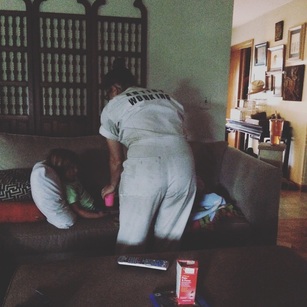 I have completed nearly 8 full months of a year long durational performance wearing the same uniform everyday without washing it. I’ve documented myself performing a range of tasks, but I see a recurrence of images of me “working in the caregiving role”. The work of caregiving is a role that I have filled in relation to my children and now, parents and partners. I have also witnessed the stress and work of caregiving first hand. The economy of caregiving is unglamorous, laborious and yet not financially lucrative, if at all. This role is especially painstaking for those who are doing this work for loved ones that are vanishing physically and mentally in front of their eyes. The 21st century is a time of extended life, and with it comes the need for extended care. This economically invisible work is falling on family members, alz.org reported that in 2015 more than 15 million caregivers provided an estimated 18.1 billion in unpaid care for an estimated economic value of $221.3 billion. (Alz.org, 2016). The uniform brings attention to the physicality of caregiving, the labor of care. As evidenced in this statement from a member of the public, “Wow, it looks like you’ve been working” *At $470 billion in 2013, the value of unpaid caregiving exceeded the value of paid home care and total Medicaid spending in the same year, and nearly matched the value of the sales of the world’s largest company, Wal-Mart ($477 billion). [AARP Public Policy Institute. (2015). Valuing the Invaluable: 2015 Update.] https://www.caregiver.org/caregiver-statistics-demographics retrieved on 8/16/2016 *. Nearly 60 percent of Alzheimer's and dementia caregivers rate the emotional stress of caregiving as high or very high; about 40 percent suffer from depression. One in five care contributors cut back on their own doctor visits because of their care responsibilities. And, among caregivers, 74 percent report they are "somewhat" to "very" concerned about maintaining their own health since becoming a caregiver. http://www.alz.org/facts/overview.asp retrieved on 8/16/2010 retrieved on 8/16/2016 * Upwards of 75% of all caregivers are female, and may spend as much as 50% more time providing care than males. [Institute on Aging. (2016). Read How IOA Views Aging in America.] https://www.caregiver.org/caregiver-statistics-demographics retrieved on 8/16/2016 here to edit.
3 Comments
|
Rebecca Kautz: Archives
June 2024
Categories |
 RSS Feed
RSS Feed